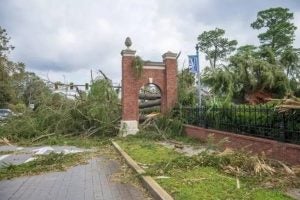Editor’s Note: If you are in the business of golf, you have to have sponsors. Georgia native Russell Henley sports the Synovus logo and hopes to wear it under a green jacket after this weekend.
If it’s April in the South, that means blooming azaleas are as automatic as Augusta National Golf Club rolling out the welcome mat to most of the world’s best golfers.
Professional golf’s first major, scheduled to begin April 10, has always held a mystical charm because of the rich-in-history club and its demanding iconic layout. Perhaps the best description of the two came from former PGA TOUR player Mac O’Grady, in 1988 when he said, “This is where God hangs out.”
In 2024, Synovus brand ambassador Russell Henley indicated he’d most love to win a major at Augusta National. This was coming off a top-five finish there in 2023, which only fed his craving to win it even more. Henley’s thinking was in line with how many players have felt over the years. In a 2012 Sports Illustrated survey, 50 PGA TOUR players were asked which major they’d like to win the most, and 50% of them responded with a victory at Augusta. The British Open rated second, at 25%.
With Augusta National among the pantheon of courses, that makes it alluring.
“For starters, it’s just so difficult to get into the tournament,” says Henley, who will make his ninth start at Augusta National. “And it has so much history. It’s rare, where the PGA Championship or U.S. Open are played on different courses a lot of times. But this has been the same golf course. You’re playing the same holes as Arnold Palmer did back in the day. The history of it’s really cool, and I feel like it’s only gotten nicer and more pristine as every year goes by.”
The event’s decorated history began in 1934 when it went by the Augusta National Invitation Tournament until 1939. That’s when the legendary Bobby Jones and club co-founder agreed to change the tournament name to what it’s known as today. Co-founder Clifford Roberts convinced Jones to switch names because the players were the “masters of golf.”
Before the tournament could even take place, though, there needed to be a course that could test all the elements of a player’s ability, according to the 13-time major champion Jones. Renowned course architect Alister MacKenzie, with Jones’s input, had 365 acres of the former Fruitland Nurseries land to mold when construction began in 1931. He and Jones agreed the design shouldn’t be overly penal. They both also knew the layout should be challenging, strategic, and aesthetically pleasing. (Over time, 80,000 plants of more than 350 varieties have been added to the course.)
Their strategy simplified: good shots should be rewarded and poor ones punished.
That said, what is it that makes the 7,555-yard, par-72 course so difficult? Why has it brought grown golfers to their knees and, at times, to cry more tears than cumulonimbus clouds bring rain?
Nick Faldo, a three-time major winner at Augusta National, said after winning in 1996, “The course is perfection, and it asks perfection.”
Said Gary Player, also a three-time major champion there: “Every shot is within a fraction of disaster; that’s what makes it so great.”
Henley doesn’t disagree, viewing it with a critical eye.
“Augusta will really test your commitment to what you’re doing because it looks like the greens are normal size, but because there are so many runoffs, there are actually very small landing areas,” he says. “And so, if you put yourself on the wrong side of the hole, you’re usually dead. It’s impossible sometimes to get the ball close.”
Part of that can be traced to certain areas around the greens that should have signage that reads, “Golfers beware.” Land in those surrounding patches, coupled with unforgiving hole locations, and it can quickly turn into a recipe for disaster trying to get up and down. Each green, due to undulation and breaks, can also spell three-putt if you’re not careful.
The front nine is unique in that each hole has a different par from its previous one, not to mention imaginative routing; no two holes head in the same direction.
Then there’s “Amen Corner,” first coined by Sports Illustrated writer Herbert Warren Wind in 1958 to describe how Palmer once played Nos. 11-13. Water comes into play on each. The 11th and 12th holes consistently rank as the second and fourth-most difficult on the course (No. 10’s normally the toughest.) The stretch has been described as treacherous.
“That stretch, it could be anything where anything can happen,” says Henley.
Henley says those holes characterize tense risk-reward gambles that could implode with balls finding water. On No. 11, “White Dogwood,” a poorly played approach could invite water, and the green requires a deft touch. Henley adds that the par-3 12th hole, “Golden Bell,” wreaks havoc on the mind because of a swirling wind off the tee at the lowest part of the property. The green, guarded by Rae’s Creek, flows back and to the right, away from the tee. On No. 13, “Azalea,” the first shots are crucial. There’s an impulse to set up for a chance at eagle, but that too could end up in Rae’s Creek if aggressively misplayed.
Adding to the psychological torment, only holes 10 and 11, as well as 17 and 18, are consecutive pars. What does this all mean? Not only can it be taxing mentally and physically, but players must be smart tacticians.
“There’s a premium on ball control and putting the ball where you’re supposed to hit it,” says Henley, who has made the cut in his past seven starts at Augusta. “And the place where you’re not supposed to hit it isn’t far away from where you’re supposed to hit it. I think it’s only gotten longer, too. And so, you’re hitting to these small areas on the greens with longer clubs.”
Heading into this year’s event at Augusta National, Henley is coming off a spirited win at the Arnold Palmer Invitational in March, his fifth career victory. It has buoyed his confidence. So, too, is knowing he can compete at Augusta National, evidenced by his fourth-place showing there in 2023. If he is to win this year, he knows it will be a full examination of skill.
“They really know how to test you out there [at Augusta], on both the mental and physical sides,” says Henley. “But the overall experience is just unlike any other there. And getting to play the same holes as all your heroes growing up is pretty cool too.”






